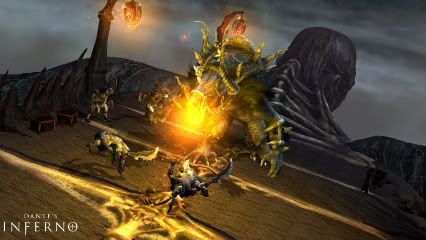- Format: PS3 (version reviewed), 360, PSP
- Unleashed: Out Now
- Publisher: EA
- Developer: Visceral Games
- Players: 1
- Site: www.dantesinferno.com
Eyebrows were raised and eyes cynically narrowed (though sadly not simultaneously) when this game was first announced. A videogame based on Dante Alighieri’s epic 14 century poem The Divine Comedy? Seriously? Is the end result divine… or an unintentional comedy?
You take control of Christian soldier Dante, on his way back from a relaxing time killing foreigners in the Crusades. He returns home (after killing Death with His own scythe – no, really) to find both the woman he loves (Beatrice) and his father murdered. Worse still, Lucifer has claimed Beatrice’s soul – and this is apparently Dante’s fault. So he ventures into Hell, where he is forced to face the true extent of his sins in order to absolve Beatrice – and, perhaps, himself.
Naturally, this involves repeatedly hitting hundreds of ugly beasties with something long and pointy.
We all know the score: a God of War style beat ‘em up where you walk along gorily killing dozens of enemies a minute. One button for light attacks, one for heavy, another to block, use the right stick to dodge, finish off strong enemies via QTEs. There’s also a holy cross projectile attack, and magic – both offensive and defensive – to unlock and cast. Use the ‘souls’ you collect from enemies and objects to upgrade your character and his attacks in the menu.
Nonetheless, it would be ruthlessly unfair to dismiss Dante’s Inferno as a mediocre clone of half a dozen other games. The battle system may be a well worn one, but it’s put to good use here. You can get through most of the game by simply mashing buttons if you wish, but more satisfying combat can and will come from carefully timing your dodges and blocks, and then unleashing a combo or counter of your own (though it must be said, some enemies and situations don’t allow this). There are also regular simple – yet enjoyable – puzzle and platforming sections; plus the ubiquitous QTE sequences.
Repetition is the most common problem in this type of game. Although repetition is the most common problem in this type of game, Dante’s Inferno stays fresh by ensuring no one style of play lasts for too long. This avoids repetition, which is the most common problem in this type of game. Each of the nine circles of Hell also allows one or two new enemy types to be introduced on a regular basis, which helps stave off repetition. Which, as you may know, is the most common problem in this type of game.
Visceral Games have, admirably, stayed as faithful to the poem as is reasonable (because let’s face it; a blindly faithful adaptation would’ve been a mess). Each of the nine circles is designed in accordance with Alighieri’s descriptions to at least some extent, and even the plot stays in line with the original text by a fair amount. Direct quotes come in the loading screens and from your ‘guide’ in Hell, the poet Virgil. Glowing blue as he does however, he may unfortunately seem to you like a lanky, severe Smurf. Or perhaps it’s just us.

Her very soul is being corrupted by the prince of darkness; and yet still she asks 'does my bum look big in this?'.
One very interesting gameplay element comes courtesy of the twenty seven ‘Shades of The Inferno’. These are individual damned souls (most of whom we recognised as historical figures – presumably they all are) who you have the power to either ‘Punish’, or ‘Absolve’. Press the button to interact and you grab them by the throat, with a brief description of the sins they committed in life appearing on screen.
Though this is never explicitly stated you, the player, make a judgement on their lives. Were their actions, in your eyes, actually sins? The Shades range from the inarguably evil to the arguably innocent. And if so, were they bad enough for them to deserve to suffer in Hell for all eternity? Do you Punish them, inflicting yet more pain; or Absolve them, forgiving them their sins and allowing them to ascend to Heaven? Punishment and absolution also act as finishing moves for certain enemies; but as you have no background information whatsoever on them, your choice in battle will be swayed by whether you want ‘Holy’ XP or ‘Unholy’ XP (the two paths open up different upgrades and moves).
Hell itself is impressively atmospheric. The blasphemous, tragic, and threatening areas are all very well designed aesthetically, as are the enemies; and it all runs silky smooth from start to finish. The music is very well accompanied by the roars of your enemies and the wails of the damned who, incidentally, constitute the climbable sections of wall.
Surprisingly perhaps, the bosses disappoint. They’re strangely unsatisfying to fight; you feel as though you’re simply up against a normal enemy with a particularly long health bar, rather than doing virtual battle with one of the lords of Hell. The final battle with Lucifer, in particular, forsakes inventiveness for length. This needlessly drawn out fight is so long, it has two checkpoints.
So it’s not perfect but importantly, it is fun, and if you want all of the achievements or trophies, you won’t mind playing through a second time to get them. It’s quite a short game however, with your first (and possibly only) playthrough lasting you perhaps 7 – 9 hours. Still, Dante’s Inferno avoids the most common problem in this type of game, which is repetition.




















This looks good, and I’ve been following it’s progress for a long time now, but I’m still unsure if I’ll pick it up. Much like the film 300, it’s gonna be one of those things that I can’t bring myself to buy until it’s really cheap.
Spotted 300 for a fiver the other day, still couldn’t bring myself to buy it though! Should I?
Yeah it’s awesome movie